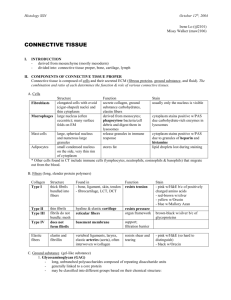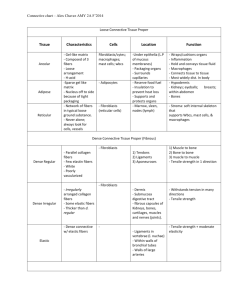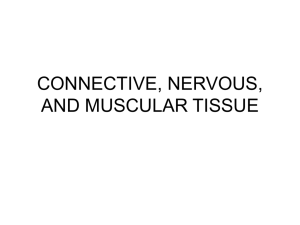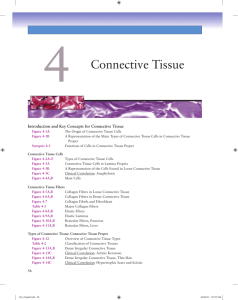CONNECTIVE TISSUE
advertisement
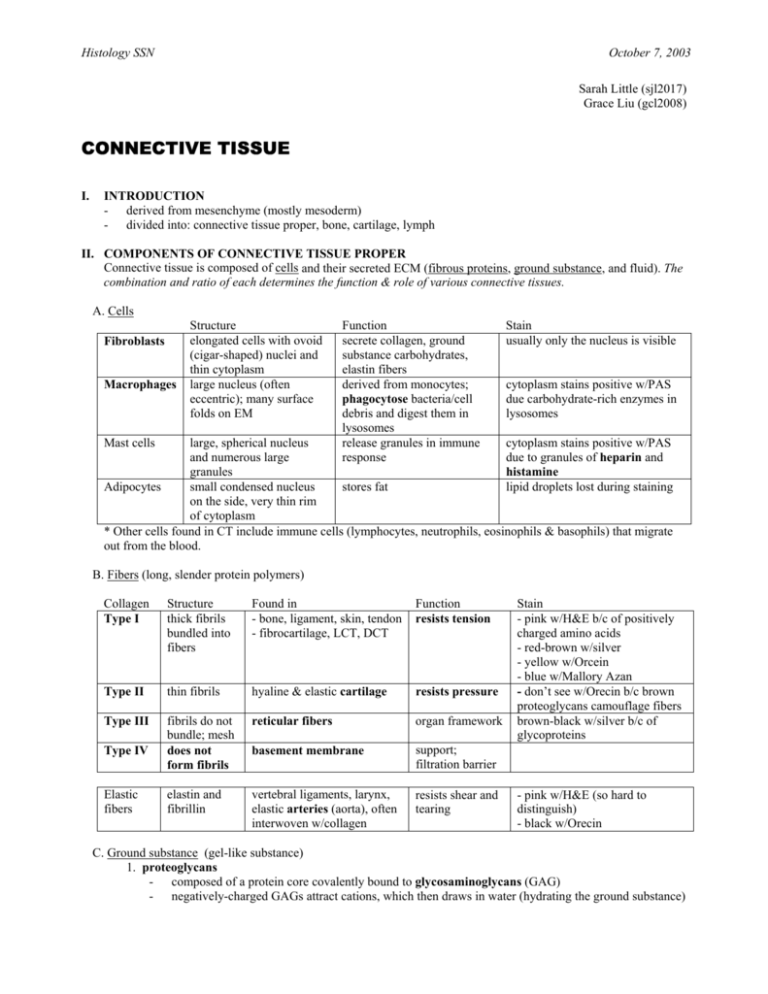
Histology SSN October 7, 2003 Sarah Little (sjl2017) Grace Liu (gcl2008) CONNECTIVE TISSUE I. INTRODUCTION - derived from mesenchyme (mostly mesoderm) - divided into: connective tissue proper, bone, cartilage, lymph II. COMPONENTS OF CONNECTIVE TISSUE PROPER Connective tissue is composed of cells and their secreted ECM (fibrous proteins, ground substance, and fluid). The combination and ratio of each determines the function & role of various connective tissues. A. Cells Fibroblasts Macrophages Structure elongated cells with ovoid (cigar-shaped) nuclei and thin cytoplasm large nucleus (often eccentric); many surface folds on EM Mast cells Function secrete collagen, ground substance carbohydrates, elastin fibers derived from monocytes; phagocytose bacteria/cell debris and digest them in lysosomes release granules in immune response Stain usually only the nucleus is visible cytoplasm stains positive w/PAS due carbohydrate-rich enzymes in lysosomes large, spherical nucleus cytoplasm stains positive w/PAS and numerous large due to granules of heparin and granules histamine Adipocytes small condensed nucleus stores fat lipid droplets lost during staining on the side, very thin rim of cytoplasm * Other cells found in CT include immune cells (lymphocytes, neutrophils, eosinophils & basophils) that migrate out from the blood. B. Fibers (long, slender protein polymers) Collagen Type I Structure thick fibrils bundled into fibers Found in - bone, ligament, skin, tendon - fibrocartilage, LCT, DCT Function resists tension Type II thin fibrils hyaline & elastic cartilage resists pressure Type III fibrils do not bundle; mesh does not form fibrils reticular fibers organ framework basement membrane support; filtration barrier elastin and fibrillin vertebral ligaments, larynx, elastic arteries (aorta), often interwoven w/collagen resists shear and tearing Type IV Elastic fibers Stain - pink w/H&E b/c of positively charged amino acids - red-brown w/silver - yellow w/Orcein - blue w/Mallory Azan - don’t see w/Orecin b/c brown proteoglycans camouflage fibers brown-black w/silver b/c of glycoproteins - pink w/H&E (so hard to distinguish) - black w/Orecin C. Ground substance (gel-like substance) 1. proteoglycans - composed of a protein core covalently bound to glycosaminoglycans (GAG) - negatively-charged GAGs attract cations, which then draws in water (hydrating the ground substance) Histology SSN October 7, 2003 2. hyaluronic acid, a GAG, attaches to the core via linker proteins 3. glycoproteins - includes fibronectin & laminin III. TYPES OF CONNECTIVE TISSUE PROPER A. loose (areolar) connective tissue 1. characteristics: - many cells per unit volume - mostly fibroblasts - includes many macrophages, lymphocytes, mast cells etc. - well vascularized (by both blood & lymph) 2. location: found beneath many epithelia (e.g. the lamina propria of GI tract) 3. specialized types: a. adipose tissue i. white adipose tissue – unilocular adipocytes ii. brown adipose tissue – mutlilocular adipocytes & many mitochondria (help in heat production) b. reticular tissue - distinctive black appearance when stained w/silver salts - contains reticular fibers (type III collagen), glycoproteins & proteoglycans - provides structural support to stroma of lymph nodes, spleen, liver, bone marrow B. dense connective tissue 1. dense irregularly arranged connective tissue (DIACT) - fibrous tissue with fewer cells (cells are mostly fibroblasts) - collagen fibers are bundles, without definite orientation - found in dermis, prostate, mammary glands, outer capsule of many organs 2. dense regularly arranged connective tissue (DRACT) - made of many fibers that run in the same direction & offer resistance to stress - forms collagenous tissue & elastic tissue a. collagenous tissue: found in tendons; - to distinguish between CT and muscle note that CT (fibroblast) nuclei are FLATTER and BETWEEN fibers (rather than within fibers), CT can look wavy due to the fixation process, muscles have striated banding patterns and stain more deeply b. elastic tissue: found in elastic ligaments of vertebral column, true vocal cords & large arteries C. embryonic connective tissue (mesenchyme) - characterized by many cells and few fibers - found around developing notochord - can differentiate into all kinds of connective tissue Histology SSN October 7, 2003 CONNECTIVE TISSUE 1. This tissue contains: a) few fibroblasts b) macrophages, which are PAS+ because of the presence of heparin c) macrophages, which are PAS+ because of lysosomal carbohydrates d) a and b e) a and c 2. This tissue contains: I. type I collagen II. type II collagen III. type III collagen IV. type IV collagen a. III only b. II only c. I & III d. I, III,& IV 3. The tissue shown is ____________ connective tissue and the extracellular matrix is secreted by _____________. a) reticular, fibroblasts b) reticular, smooth muscle c) elastic, fibroblasts d) elastic, smooth muscle 4. The tissue type shown here is specialized primarily for withstanding: a) tearing/shear forces b) compressive forces c) acid secretions d) a and b e) none of the above Histology SSN October 7, 2003 ANSWERS: 1. (loose connective tissue, demonstrating macrophages – PAS stain) – C. Loose connective tissue has many cells, which are mostly fibroblasts, and relatively little fibrous protein. The immune cells found in LCT include macrophages, which stain positively with PAS due to the oxidation of carbohydrates in lysosomal enzymes by periodic acid. 2. (pointer on lymph node - silver stain) – D. Type I in the capsule, type III in reticular tissue, and type IV in basement membrane of the cells. 3. (Slide of aorta showing elastic tissue) – D. The wall of the aorta is an example of elastic connective tissue. The elastic tissue in arteries is secreted by smooth muscle cells, NOT fibroblasts (which secretes elastic tissue elsewhere) 4. (Slide of dense, irregular CT in dermis) - A. Dense irregular CT is specialized for resisting tearing and shearing forces, such as those experienced by the skin on a daily basis. Its fibers are arranged in many different directions and planes to withstand the stress from many directions. It does not resist compression in the same way that cartilage does (type II collagen v. the type I of dense CT); however, it is strong and can withstand a limited amount of forces and pressure. -
